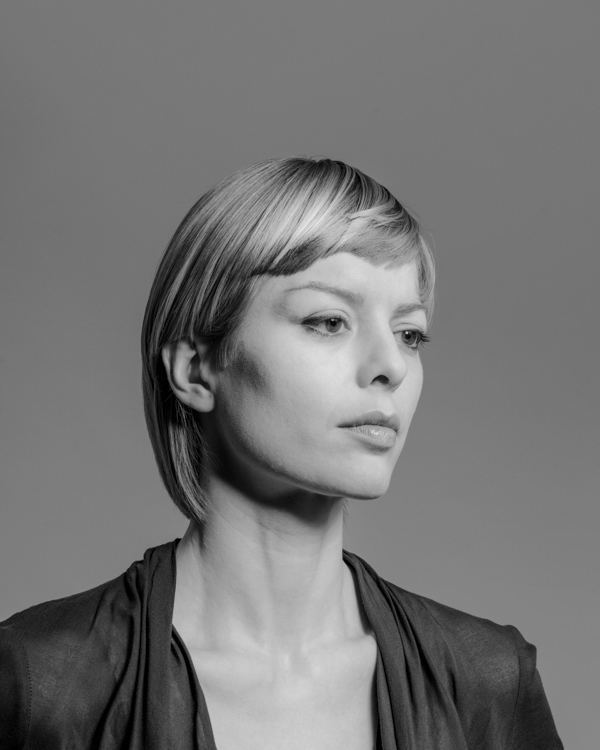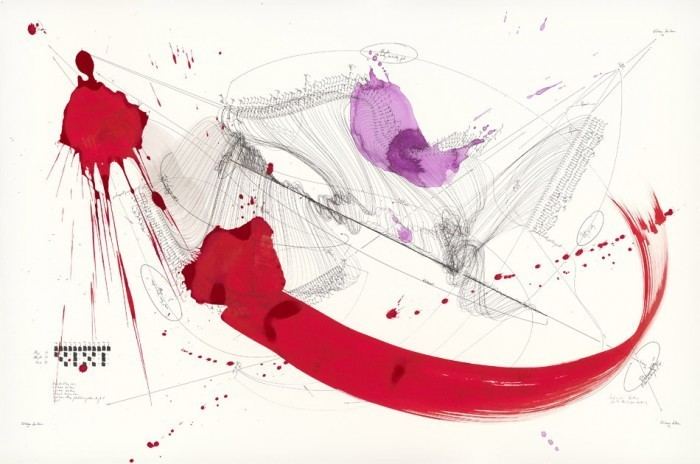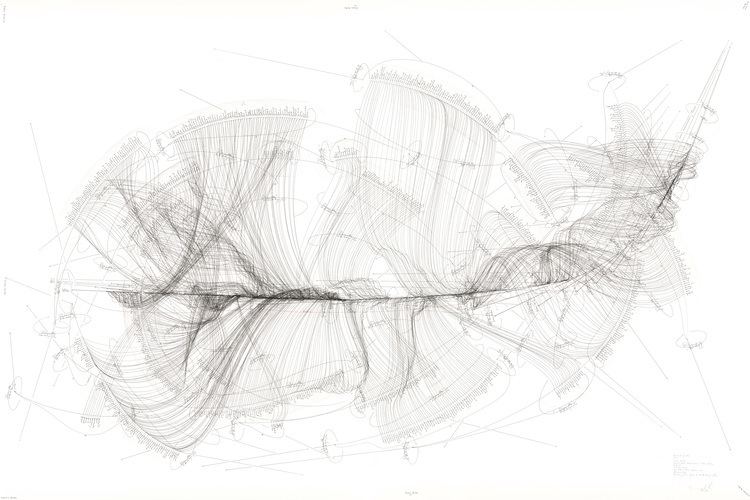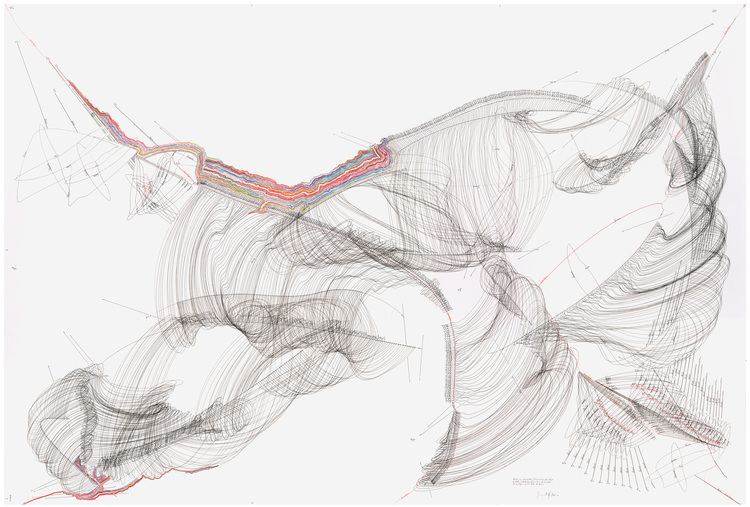 | ||
Similar Alicja Kwade, Gregor Hildebrandt, Christian Jankowski, Hans‑Peter Wipplinger, Jochen Kienbaum | ||
K nstlerportrait jorinde voigt vogue interview
Jorinde Voigt (born January 19, 1977 in Frankfurt am Main) is a German artist who works in drawing, text, painting and installation. She has been teaching conceptual drawing and painting at the Academy of Fine Arts, Munich since 2014.
Contents
- K nstlerportrait jorinde voigt vogue interview
- Jorinde voigt in her berlin studio
- Life and work
- Black and white
- Color
- Collage
- Gold
- Installation
- Exhibitions selection
- Literature selection
- References

Jorinde voigt in her berlin studio
Life and work

After graduating from the Viktoriaschule high school in Darmstadt in 1996, Voigt studied philosophy and modern German literature at the University of Göttingen. In 1998 Jorinde Voigt moved to Berlin to study sociology, philosophy and comparative literature at the Freie Universität. From 1999 to 2003 she studied art at the Berlin University of the Arts in the multimedia department with Christiane Möbus. In 2001 she was a student in Visual Art Studies at the Royal College of Art, London, as part of the Erasmus European university exchange programme. She then continued her studies in Berlin in Katharina Sieverding's Fine Art and Photography class, from which she graduated in 2004 as Meisterschuler. During her school years 1986-1996, Voigt had learnt cello at the Akademie fur Tonkunst [Academy of Sonic Arts] in Darmstadt, as well as with Peter Wolf in Frankfurt.

Jorinde Voigt is presently represented by numerous galleries and her work is in several museums and private and public collections, such as the Centre Pompidou in Paris, the Museum of Modern Art in New York, the Art Institute of Chicago, Kupferstichkabinett in Berlin, the Federal Art Collection Bonn, the Hamburger Kunsthalle in Hamburg, and the Grafische Sammlung in Munich. In 2008, Jorinde Voigt was awarded the Otto Dix award by the city of Gera and the Daniel & Florence Guerlain Contemporary Drawing award in 2012. The coded syllabary that the artist developed in her notations and scores allows her to turn complex phenomena into visual composition. During the early years of her artistic career, Voigt concerned herself with visualising scientific and cultural phenomena. Her recent work deals less with external processes than with mental images and imaginary worlds.

Their three-dimensional and painted works can also be read as conceptual models of thought, through which the artist examines reality and perception. Within her extensive body of work, Voigt experiments with work practises and with different materials that are ceaselessly varied, combined and developed.
Jorinde Voigt lives and works in Berlin.
Black and white

It was only relatively late during artistic education that Jorinde Voigt rediscovered the media of drawing and writing that she principally works with today. After early photographic works about typical cultural motifs of North American cities, she moved on from photography and the reproduction of already existing images in favour of experiments on paper, focussing on characteristics of situations such as time, space, speed and form.[1] Voigt began to draw snapshots of her immediate environment during a stay in Florida in 2003. She created notation scores on paper in small format. The same year, while travelling in Indonesia, she collected sonic inventories. She began to translate the frequencies of events into lines, numbers, arrows and parentheses and to arrange these on paper following a particular system. "At that time, my approach was to examine the frequency of events that characterise a specific cultural situation. This was more or less a transcription of reality."[2] Between 2003 and 2010 Voigt produced numerous studies and large-format series in black and white ink on paper. These works are based on strict rules, algorithms and arithmetic parameters. Since that time, Voigt has been concerned with capturing invisible everyday phenomena. She examines processes in mathematics, biology, physics, music and politics: Temperaturverlaufe (temperature patterns), Popsongs, Pulsschlage (pulse), Adlerfluge (eagle flights),sich kussende Paare (kissing couples), Himmelsrichtungen(cardinal directions), Windrichtungen (wind directions),Lichtbogen (lights arcs), Elektrizitat (electricity), Detonationen(explosions), Schussfelder (fields of fire)or Rotationen (rotations) are named as parameters of their drawings. Her goal is not to simply depict, but to constructing a new way of looking at the world in all its complexity, in its multiple layers and its simultaneities. "Finding a structure or a notation that remains as alive as possible, given that it is a living thing that is being observed".[3] Jorinde Voigt's drawings become "graphical world detection machines".[4] Works such as 22 kussen sich I-VI (2 kiss I-VI, 2006), Konstellation Algorithmus Adlerflug (constellation algorithm eagle flight 2007), PERM I-III (2007), ReWrite I-VI (2008), STAAT/Random I-XI (STATE/Random I-XI 2008) and Symphonic Area Var. 1-27 (2009) are from this phase of work. Around this time Jorinde Voigt began to work with large sheets of paper. The body and its scale thus became very significant. The artist jotted down notations beginning at eachedge of the paper towards its centre, and, over months of painstakingly precise work, covered the entire surface of the paper with meticulous lines, numbers and letters in graphite and ink. Voigt produced variations, order and chaos on the paper by switching between through self-imposed rules (algorithms) and spontaneously deviating from these rules. This makes for a dynamism and vitality that sets her black and white works apart from the strictly regimented drawings of conceptual art such as those of Hanne Darboven.[5]
Color

Voigt began working with colour in 2009. For the installation Botanic Code (2009/2010), the artist examined her own perception of colours during walks through various botanical gardens worldwide. She transposed the colours she perceived most strongly into swatches of colours that were in turn transposed onto aluminium rods, forming a code of sorts that provides data about colours, proportion and season. The installation translates the human brain's linear perceptual structure to a parallel arrangement that allows for the data to be captured visually at once.[6] The drawings and sketches of Superdestinations (2010) show abstract lines drawn in coloured pencil and distributed intuitively over the surface of the paper. The title alone indicates the object that the notations refer to: concrete determinations of position noted in the synchronised parameters of form and colour. In Superdestinations, the examined object is abbreviated to its simplest visual base form at the moment of its perception and coded with the corresponding colour.[7] Jorinde Voigt developed the concept of horizons in 2010, giving birth to the series Interhorizontal Nexus I-VII (Kiev 1-7) (2010). The horizon, so Voigt, is one of the most fundamental lines in landscape, one that humans use for orientation, align and tune themselves to. In large drawings (that have by now reached a format of 258 x 208 cm), Voigt presents variations of possible colour spectra and curvatures of horizons.
Collage
Voigt began to combine her notation method with collage technique in 2011. The series 308 Views on Plants and Trees(2011), features layers of delicate filigree lines, curves and abstract fields of coloured paper. The latter are silhouettes cut with scissors, the outlines of which Voigt derived from her observation of different species of tree. Each coloured silhouette represents one perspective of the artist. While the first sight from a distance forms an overview, the gaze movescloser to the flora's structures with each one of the silhouettesthat stand for a specific gaze (the “views” referred to in the title) of the artist. Jorinde Voigt's precise study of the different species of trees corresponds to the idea that underlies all of her work: the understanding of reality as a microcosm.[8] The series Views on Chinese Erotic Art. From 16th to 20th Century (2011) followed in this lineage. The series references paintings from the exhibition The Chinese Pleasure Garden – Erotic Art from the Bertholet collection of the museum of East-Asian Art in Dahlem (2011). Jorinde Voigt is fascinated by the characteristics of erotic painting and woodblock prints and concerns herself with their shapes and colours. Per drawing she created up to 100 views on the erotic works, singa colour chart to determine the corresponding colour codes of the garments, lovers, wallpaper and furniture depicted. Elements such as tables, mirrors, hair, genitalia or feet can be made out. Some of the coloured areas recall the colouring of drawings in comics.[9]Colors and shapes are conjugated hundredfold in Voigt's collages in order to bring out the characteristics of the object observed. This approach is a reference to the Chinese and Japanese painting tradition that captured a scene in multiple views, most famously Hokusai's 36 Views of Mount Fuji (1830-1836).After botany and the visual arts, the artist turned her attention to literature as a research field: the 36-part series Piece for Words and Views(2012) is based on Roland Barthes's essay A Lover's Discourse Fragments(1978). Each colour corresponds to a quoted word, e.g. “coil”, “lake”, “Werther” or “heart”. These are the works that sparked spontaneous images in the artist's imagination while reading. Her inner images are marked both by a collective memory as well as by her individual experiences. The result is a mix of figurative and abstract representation.[10]Piece for Words and Views(2012) marked a significant change in Jorinde Voigt's work. From this point onward, the artist focussed her attention on the possibility of finding images out of internal processes. Aspects of imagination, memory, experience and emotion moved to the fore of her work.
Gold
Jorinde Voigt has been studying literary and philosophical works since 2012 and has, since this phase of work, been experimenting with gold leaf and marquetry techniques, resulting in drawings relating to Schopenhauer, Deleuze and Guattari, Epicurus, Goethe, Sloterdijk, Hofstadter, Plato, Canetti, Paul Celan and C. G. Jung. Voigt allows the viewer to be privy to her process of appropriation and attempts to understand the texts. She cuts out the surfaces contoured with pencil, adorns them with leaf gold and white gold, silver, platinum or palladium, and places it back to its original spot in the drawing. She then reworks the drawing with watercolour, pastels and oil pastels. The materiality of gold stands out among the general composition. From a distance and depending on the viewer's position the shimmering and reflective precious metal seems to take on different shapes. This effect reflects Jorinde Voigt's notion that ideas and images – represented by the gold surfaces – always change. The handwritten notation method took a back seat during this phase of work. The inner dynamics of the works, formerly brought out in her drawings in writing through spatial and temporal parameters, are now expressed through the use of precious metals.Voigt worked on the 48-part series Liebe als Passion. Zur Codierung von Intimitat [Love as passion. On the coding of intimacy] from 2013 to 2014, studying sociologist Niklas Luhmann's eponymous book from 1982. Compared to previous works, the quoted words now seem to emancipate themselves and form completely new visual worlds. Pictorial elements gain the upper hand while sign, script and text retreat to the background. From that point on Voigt's work becomes painterly: her visual language of imagination, figuration and abstraction, as well as the inherent rhythm of her serial visual compositions are reminiscent of the works of modern painters such as Wassily Kandinsky and Paul Klee [11]. The series Inkommunikabilitat [Incommunicability] (2014) and A difference that makes a difference (2014) belong to this group of works
Installation
In her sculptural practise parallel to her drawings, Jorinde Voigt translates their underlying concepts into three-dimensional objects and installations. These include MI & MII(Action and Communication Study) (2009), Botanic code(2009–2010), Grammatik [grammar] (2010) and Collective Time (2010). In 2012 she created sculptural works made of fluorescent tubes in response to Roland Barthes's essay A Lover's Discourse:Fragments. Voigt transposed selected words from her reading and spells them with fluorescent tubes, labelled with the quote they were lifted from and chapter citation. The imagined images become visible as coloured luminous lines.
